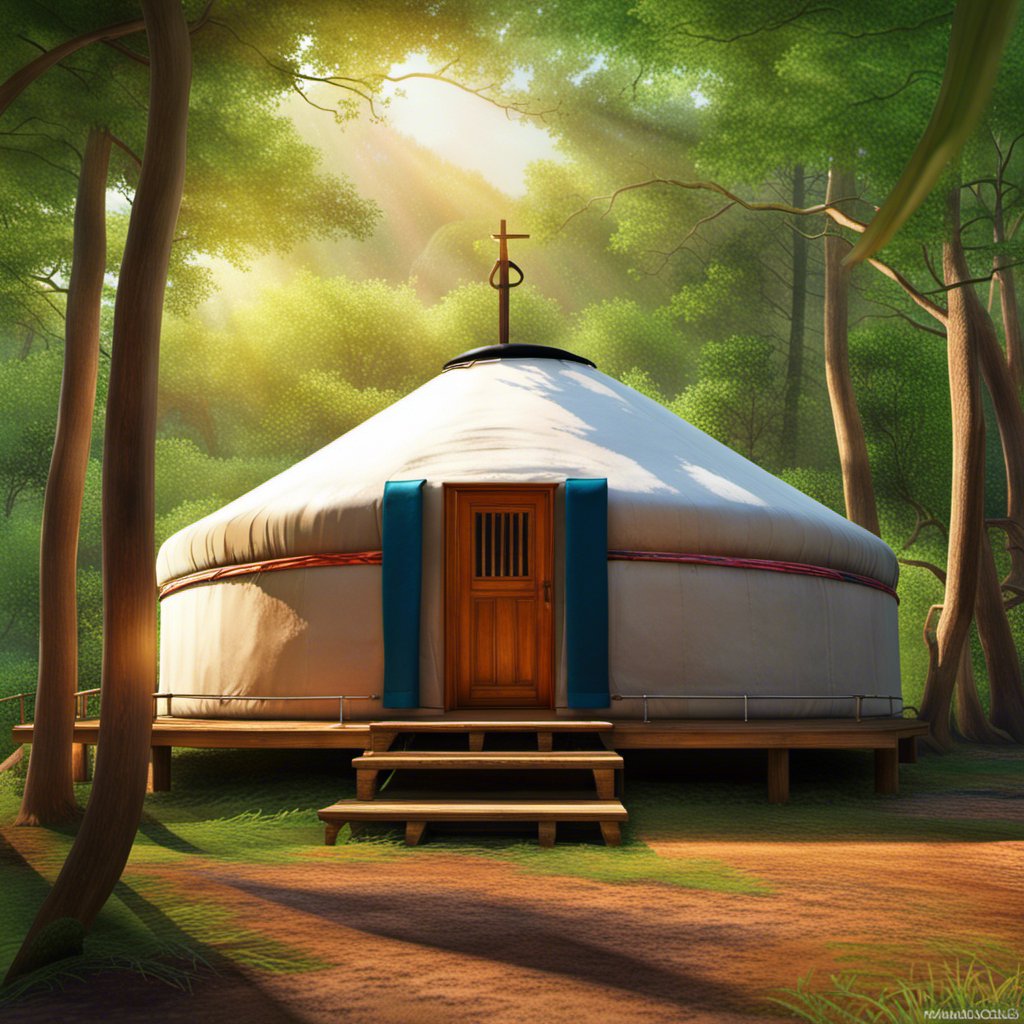Pros and Cons of Yurt Living: A Comprehensive Guide
Yurts have been gaining popularity as alternative dwellings in recent years. They are circular, portable structures made of a lattice frame covered with canvas or other materials. Yurts are known for their affordability, ease of assembly, and versatility.
Living in a yurt can be an exciting and unique experience, but it also has its challenges. In this article, you will learn the pros and cons of yurt living.
We will discuss the benefits of yurts such as their affordability, portability, and eco-friendliness.
We will also examine the downsides of living in a yurt, including limited space, lack of privacy, and susceptibility to extreme weather conditions.
By the end of this article, you will have a better understanding of whether yurt living is right for you.

Advantages and Disadvantages of Yurt Living
Yurts offer a unique and affordable living experience that has become increasingly popular in recent years.
However, like any living arrangement, there are both advantages and disadvantages to consider before making the decision to live in a yurt.
Advantages
- Affordability: Yurts are generally more affordable than traditional homes, making them an attractive option for those looking to downsize or live off the grid. With prices starting at under $10,000, yurts are a great option for those on a budget.
- Ease of construction: Yurts are relatively easy to construct, with many companies offering pre-fabricated kits that can be assembled in a matter of days. This makes them a great option for those looking to build their own home without the need for extensive construction experience.
- Portability: Yurts can be easily disassembled and moved, making them a great option for those who want to live a more nomadic lifestyle. This also makes them a great option for those who want to live off the grid in remote locations.
- Eco-friendly: Yurts have a minimal impact on the environment, making them a great option for those who are environmentally conscious. They use fewer resources than traditional homes and can be built using sustainable materials.
Disadvantages
- Limited space: Yurts have limited space, which can make it difficult for families or those who require a lot of space to live comfortably. While there are larger yurts available, they can be more expensive and may not be practical for everyone.
- Limited amenities: Yurts often have limited amenities, such as running water and electricity. While these can be added, it can be more difficult and expensive to do so than in a traditional home.
- Climate control: Yurts can be difficult to heat and cool, especially in extreme weather conditions. This can make them uncomfortable to live in during certain times of the year.
- Durability: Yurts are not as durable as traditional homes and may require more maintenance. They are also more susceptible to damage from extreme weather conditions, such as strong winds and heavy snow.
Overall, yurt living can be a great option for those looking for an affordable, eco-friendly, and unique living experience. However, to weigh the advantages and disadvantages before making the decision to live in a yurt.
Pros of Yurt Living
Yurt living has become increasingly popular in recent years (Check if you can live in a yurt year round) due to its affordability, flexibility, and environmentally friendly nature.
In this section, we will explore some of the main pros of yurt living.
Affordability
One of the biggest advantages of yurt living is its affordability. Yurts are much less expensive than traditional homes, and they can be built for a fraction of the cost. In 2023, there are still yurts available for under $10,000. For example, the base 12-foot unit at Pacific Yurts costs $7,990 plus $250 shipping, while Colorado Yurts has a 16′ model for $12,430. This makes yurts an excellent option for those who want to live mortgage-free or are looking to downsize.
Flexibility
Another advantage of yurt living is its flexibility. Yurts can be built in a variety of locations, including rural areas, suburban neighborhoods, and even urban settings.
They can also be customized to fit the specific needs of the homeowner, with options for insulation, windows, and doors.
Additionally, yurts can be easily disassembled and moved to a new location, making them an excellent option for those who want to travel or relocate frequently.
Environmentally Friendly
Yurts are an environmentally friendly housing option. They have little impact on the land, making them a more eco-friendly shelter option. Since yurts are significantly smaller than traditional homes, they use fewer resources to build and maintain.
Moreover, yurts can be powered using alternative energy sources such as solar panels and wind turbines, further reducing their impact on the environment.
Low Maintenance
Yurts are also relatively low maintenance compared to traditional homes.
They require less cleaning, upkeep, and repairs due to their simple design and construction.
In addition, yurts are resistant to pests and mildew, making them an excellent option for those who want to avoid using harsh chemicals to maintain their homes. Overall, yurt living offers an affordable, flexible, environmentally friendly, and low-maintenance housing option for those who want to live a simpler, more sustainable lifestyle.
Cons of Yurt Living
Living in a yurt has its advantages, but it also comes with some disadvantages. In this section, we will take a closer look at some of the cons of yurt living.
Lack of Privacy
One of the biggest drawbacks of yurt living is the lack of privacy. Since yurts are typically one large circular room, it can be challenging to find a private space to relax or work. Plus, sound travels easily in a yurt, so it can be difficult to have a private conversation without being overheard.
Weather Challenges
Yurts are not as weather-resistant as traditional homes. They are not as well insulated, and the fabric walls can be damaged by heavy rain, snow, or wind. In cold weather, it can be challenging to keep a yurt warm, and in hot weather, it can be challenging to keep it cool. If you live in an area with extreme weather conditions, a yurt may not be the best option for you.
Pest Issues
Another disadvantage of yurt living is the potential for pest issues. Since yurts are made of fabric, they are not as pest-resistant as traditional homes. Insects, rodents, and other pests can easily find their way into a yurt, and once they are inside, they can be challenging to get rid of. If you live in an area with a lot of pests, you may want to consider a different type of dwelling.
Overall, while yurt living can be a unique and exciting experience, it is not without its challenges. If you are considering yurt living, it is essential to weigh the pros and cons carefully and make an informed decision based on your lifestyle and needs.
Comfort and Amenities
Living in a yurt can offer a unique and comfortable experience for those who enjoy a minimalist lifestyle. However, to consider the amenities that are available in a yurt before making the decision to live in one.
Heating and Cooling
One of the biggest concerns with living in a yurt is the ability to regulate temperature. Yurts are typically made of lightweight materials and have limited insulation, which can make it difficult to keep them warm in cold weather. However, there are several options for heating a yurt, including wood stoves, propane heaters, and electric heaters. To consider the cost of heating a yurt, as some methods can be expensive.
In the summer, yurts can become hot and stuffy. To combat this, many yurts have windows and vents that can be opened to allow for air flow. Additionally, some yurts come with a built-in air conditioning unit or a portable air conditioner can be used.
Plumbing and Electrical
Yurts typically do not come with plumbing or electrical systems installed. However, it is possible to add these amenities to a yurt. Plumbing can be installed using a septic system or composting toilet, and electrical can be installed using solar panels or a generator. To consider the cost of installation and maintenance for these systems.
Storage Space
Yurts typically have limited storage space due to their circular design. However, there are several options for maximizing storage space, including built-in shelves and cabinets, hanging storage, and under-bed storage. You need to consider the amount of storage space needed before choosing a yurt.
Overall, living in a yurt can offer a unique and comfortable experience for those who enjoy a minimalist lifestyle. But you have to consider the amenities available in a yurt and the associated costs before making the decision to live in one.
Legal Considerations
Permits and Zoning
Before deciding to live in a yurt, you have to research the permits and zoning regulations in your area. Yurts may not be allowed as permanent housing structures in some places, while in others, they may only be allowed as auxiliary structures. It is also important to note that some areas may require permits for the construction of a yurt, while others may not.
Taxes
When it comes to taxes, yurt living may offer some advantages. Since yurts are considered personal property rather than real property, they may be subject to fewer taxes than traditional homes. So before going to build a yurt do some research the tax laws in your area to determine the exact tax implications of living in a yurt.
It is also important to note that building codes may come into play when it comes to yurt living. While yurts have a smaller environmental impact and use fewer resources than traditional homes, they may still be subject to building codes and regulations. You have to research the building codes in your area to ensure that your yurt meets all necessary requirements.
Overall, while yurts offer a unique and eco-friendly living experience, you need to consider the legal considerations before deciding to live in one. By researching the permits, zoning regulations, taxes, and building codes in your area, you can ensure that your yurt is a legal and safe place to call home.
Yurts as Alternative Living Spaces
Yurts are becoming increasingly popular as alternative living spaces. They offer a unique and affordable way to live off the grid or simply downsize from a traditional home. In this section, we will explore some of the different ways yurts can be used as alternative living spaces.
Tiny House Living
Yurts are a great option for those interested in tiny house living. They are relatively inexpensive to build and can be customized to fit your specific needs. Yurts are also very energy-efficient and can be heated with wood stoves or other alternative heating sources. With their circular design, yurts are also very spacious and can feel much larger than their actual square footage.
Glamping
For those interested in glamping, or glamorous camping, yurts are a perfect fit. They offer a unique and luxurious camping experience with all the comforts of home. Yurts can be outfitted with comfortable beds, furniture, and even kitchenettes. They are also very sturdy and can withstand harsh weather conditions, making them a great option for year-round glamping.
Guest Houses
Yurts also make great guest houses. They can be built relatively quickly and provide a comfortable and private space for guests. Yurts can be customized with all the necessary amenities, including bathrooms, kitchens, and heating sources. They are also very versatile and can be used as a guest house, home office, or even a yoga studio.
Overall, yurts offer a unique and affordable alternative to traditional living spaces. They can be customized to fit your specific needs and offer a comfortable and eco-friendly living space. Whether you are interested in tiny house living, glamping, or need a guest house, yurts are a great option to consider.
Conclusion
Living in a yurt can be a unique and rewarding experience, but it’s not for everyone. As with any housing option, there are pros and cons to consider before making a decision. In this article, we’ve covered some of the most important factors to keep in mind when it comes to yurt living.
One of the biggest advantages of yurt living is the low cost of construction and maintenance. Yurts are often much less expensive than traditional homes, and they require very little upkeep. They can also be a great option for those who want to live off the grid or in a more natural setting.
However, there are also some downsides to yurt living. One of the biggest challenges is the lack of privacy. Yurts are typically open in design, which means that there are few barriers between different living spaces. This can make it difficult to find quiet time or personal space.
Another potential issue is the lack of insulation. While yurts can be quite comfortable in moderate climates, they may not be well-suited to extreme temperatures. Those who live in colder areas may need to take extra steps to insulate their yurts and keep them warm during the winter months.
Overall, yurt living can be a great option for those who are looking for an affordable and unique housing option. You have to carefully consider the pros and cons before making a decision. By doing so, you can ensure that you choose the housing option that is best suited to your needs and lifestyle.
Next to read: Is It Possible to live in a yurt in Ontario?








